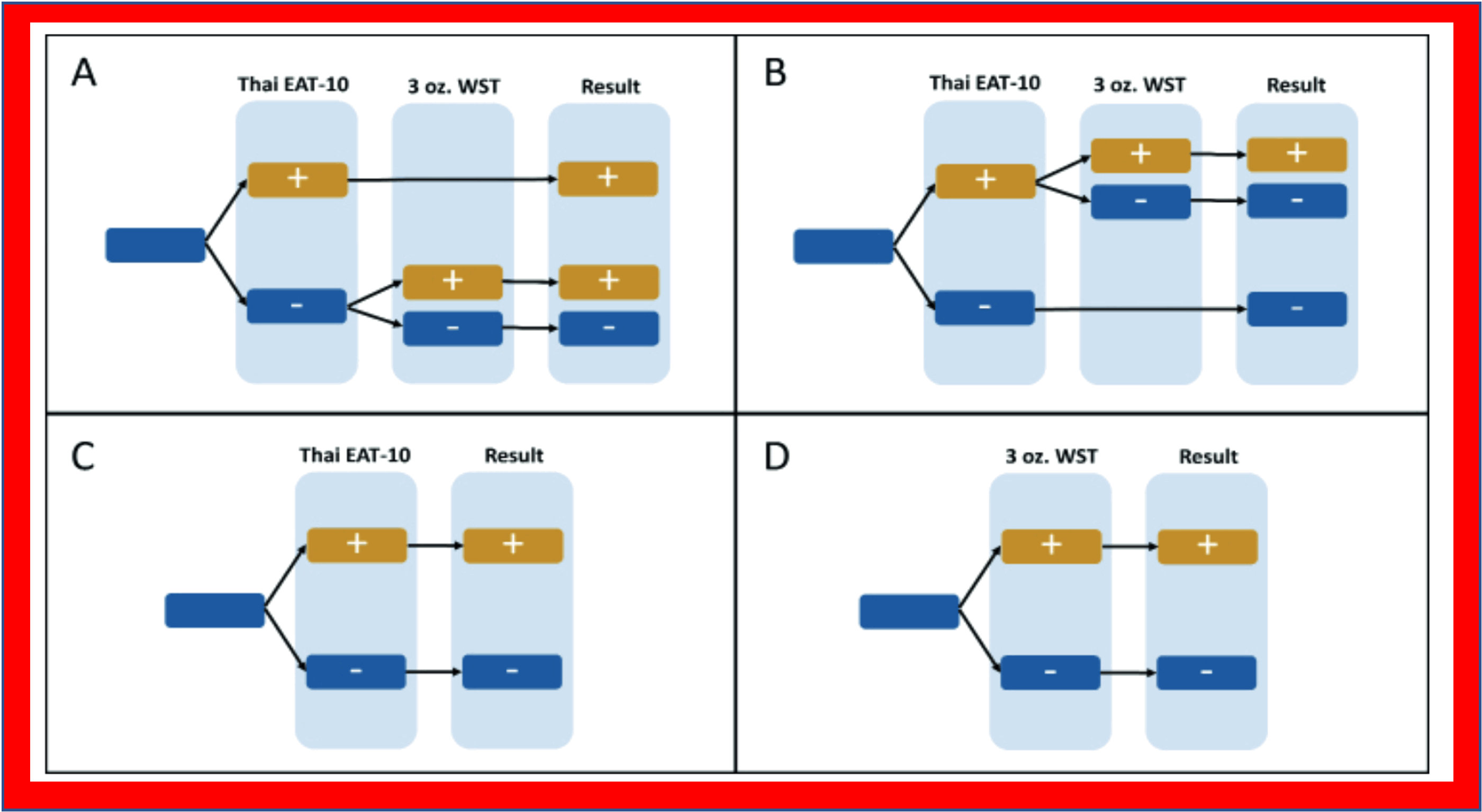Screening algorithms for detecting dysphagia: A validation study of Thai EAT-10 combined with the 3-Ounce Water Swallow Test
Main Article Content
Abstract
Background: Dysphagia assessment using standard tools is not commonly performed in Thailand because it relies on equipment and experts to evaluate. This study was conducted by combining the Thai EAT-10 and the 3-ounce water swallow test, an easy-to-use tool for dysphagia screening. Therefore, it is crucial to study the accuracy and appropriateness before being widely used in the Thai population.
Objectives: To evaluate the validity of the combined Thai Eating Assessment Tool 10 (Thai EAT-10) and the 3-ounce Water Swallow Test (WST) screening algorithm for detecting dysphagia compared to diagnosis by an otolaryngologist.
Materials and methods: Analytical Cross-sectional study: sample of 260 adults (aged 20 years old or older) demographic data and past medical history were assessed using a questionnaire. The accuracy of dysphagia screening tests that combine Thai EAT-10 and the 3-ounce water swallow test with pulse oximetry was compared to the clinical swallow test assessed by an otolaryngologist. The sensitivity and specificity of the swallowing screening test for detecting dysphagia were evaluated.
Results: Thai EAT-10 combined with the 3-ounce Water Swallow Test has higher validity and accuracy for dysphagia evaluation than those of the Thai EAT-10 or the 3-ounce Water Swallow Test alone. There was 100% sensitivity, 93.4% specificity, 68.1% positive predictive value (PPV), and 100% negative predictive value (NPV).
Conclusion: The Thai EAT-10 combined with the 3-ounce water swallow test and pulse oximetry has higher reliability and validity than those of the Thai EAT-10 and the 3-ounce water swallow test alone. The reliability and validity of the combined test is closed to the gold standard. Furthermore, the algorithm is appropriate for screening dysphagia in remote areas with a large population.
Article Details

This work is licensed under a Creative Commons Attribution-NonCommercial-NoDerivatives 4.0 International License.
Personal views expressed by the contributors in their articles are not necessarily those of the Journal of Associated Medical Sciences, Faculty of Associated Medical Sciences, Chiang Mai University.
References
Namasivayam-MacDonald AM and Riquelme F. Presbyphagia to dysphagia: multiple perspectives and strategies for quality care of older adults. Semin Speech Lang. 2019; 40: 227-42. doi: 10.1055/s-0039-1688837.
Logemann JA. Role of the modified barium swallow in management of patients with dysphagia. Otolaryngol Head Neck Surg. 1997; 116(3): 335-8. doi: 10.1016/S0194-59989770269-9.
Logemann JA. Swallowing disorders. Best practice & research Clinical gastroenterology. 2007; 21(4): 563-73. doi: 10.1016/j.bpg.2007.03.006.
Bax L, McFarlane M, Green E, Miles A. Speech-language pathologist-led fiberoptic endoscopic evaluation of swallowing: functional outcomes for patients after stroke. J Stroke Cerebrovasc Dis. 2014; 23(3): e195-e200. doi: 10.1016/j.jstrokecerebrovasdis.2013.09.031.
Mann G, Hankey GJ, Cameron D. Swallowing function after stroke: prognosis and prognostic factors at 6 months. Stroke. 1999; 30(4): 744-8. doi: 10.1161/01. str.30.4.744.
Brodsky MB, Suiter DM, González-Fernández M, Michalik HJ, Frymark TB, Venediktov R, et al. Screening accuracy for aspiration using bedside water swallow tests: a systematic review and meta-analysis. Chest. 2016; 150(1): 148-63. doi: 10.1016/j.chest.2016.03.059.
Suiter DM, Leder SB. Clinical utility of the 3-ounce water swallow test. Dysphagia. 2008; 23(3): 244-50. doi: 10.1007/s00455-007-9127-y.
Belafsky PC, Mouadeb DA, Rees CJ, Pryor JC, Postma GN, Allen J, et al. validity and reliability of the Eating Assessment Tool (EAT-10). Ann Otol Rhinol Laryngol. 2008; 117(12): 919-24. doi: 10.1177/000348940811701210.
Rofes L, Arreola V, Mukherjee R, Clavé P. Sensitivity and specificity of the Eating Assessment Tool and the Volume‐Viscosity Swallow Test for clinical evaluation of oropharyngeal dysphagia. Neurogastroenterol Motil. 2014; 26(9): 1256-65. doi: 10.1111/nmo.12382.
Nogueira DS, Ferreira PL, Reis EA, Lopes IS. Measuring outcomes for dysphagia: validity and reliability of the European Portuguese Eating Assessment Tool (P-EAT-10). Dysphagia. 2015; 30(5): 511-20. doi: 10.1007/s00455-015-9630-5.
Giraldo-Cadavid LF, Gutiérrez-Achury AM, Ruales-Suárez K, Rengifo-Varona ML, Barros C, Posada A, et al. Validation of the Spanish Version of the Eating Assessment Tool-10 (EAT-10 spa) in Colombia. A Blinded Prospective Cohort Study. Dysphagia. 2016; 31(3): 398-406. doi: 10.1007/s00455-016-9690-1.
Müller M. Nursing competence: psychometric evaluation using R asch modeling. J Adv Nurs. 2013; 69(6): 1410-7. doi: 10.1111/jan.12009.
Wakabayashi H, Kayashita J. Translation, reliability, and validity of the Japanese version of the 10-item Eating Assessment Tool (EAT-10) for the screening of dysphagia. JJSPEN. 2014; 29: 871-6. doi: 10.11244/jjspen.29.871.
Demir N, Arslan SS, Inal O, Karaduman AA. Reliability and validity of the Turkish Eating Assessment Tool (T-EAT-10). Dysphagia. 2016; 31(5): 644-9. doi: 10.1007/s00455-016-9723-9.
Korwanich K, Korwanich N, Kongma P, Klibngern H and Tavisak N. Validation of the Thai version of the
Eating Assessment Tool-10 (Thai EAT-10)[Report]. Faculty of Dentistry: Chiang Mai University; 2021.
Igarashi K, Takeshi K and Fumiyo T. Survey of suspected dysphagia prevalence in home-dwelling older people using the 10-Item Eating Assessment Tool (EAT-10). PLoS One. 2019; 14(1): e0211040. doi: 10.1371/journal. pone.0211040.
Pokharel S, White LJ, Sacks JA, Escadafal C, Toporowski A, Mohammed SI, et al. Two-test algorithms for infectious disease diagnosis: Implications for COVID-19. PLOS Global Public Health. 2022; 2(3): e0000293. doi: 10.1371/journal.pgph.0000293.
Dajpratham P. Dysphagia in Elderly. J Thai Rehabil Med. 2013; 23(3): 73-80[in Thai].


